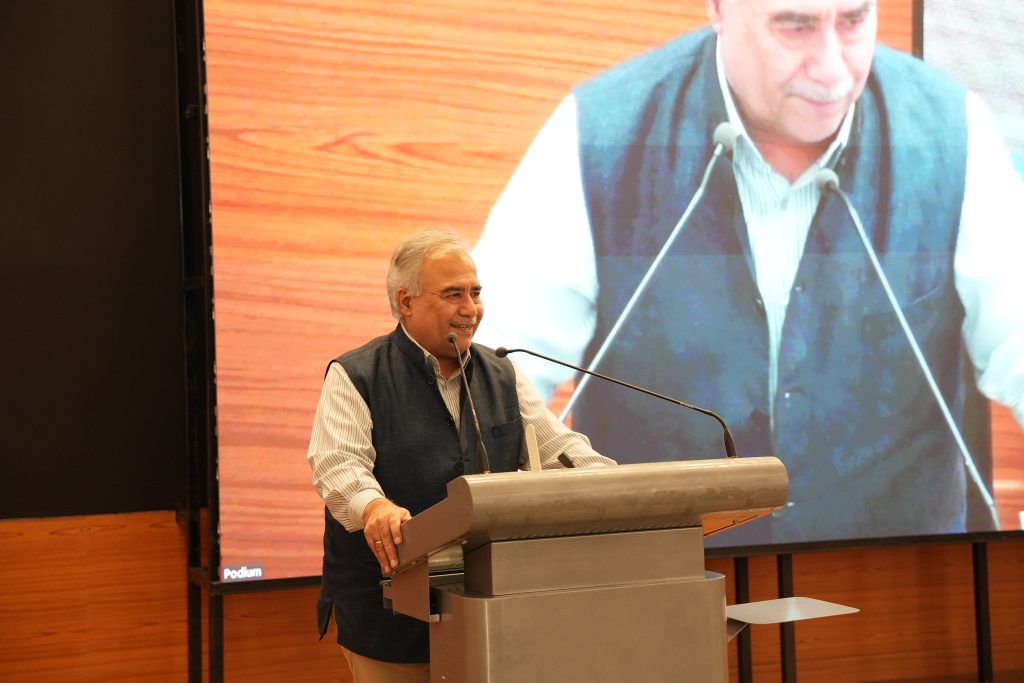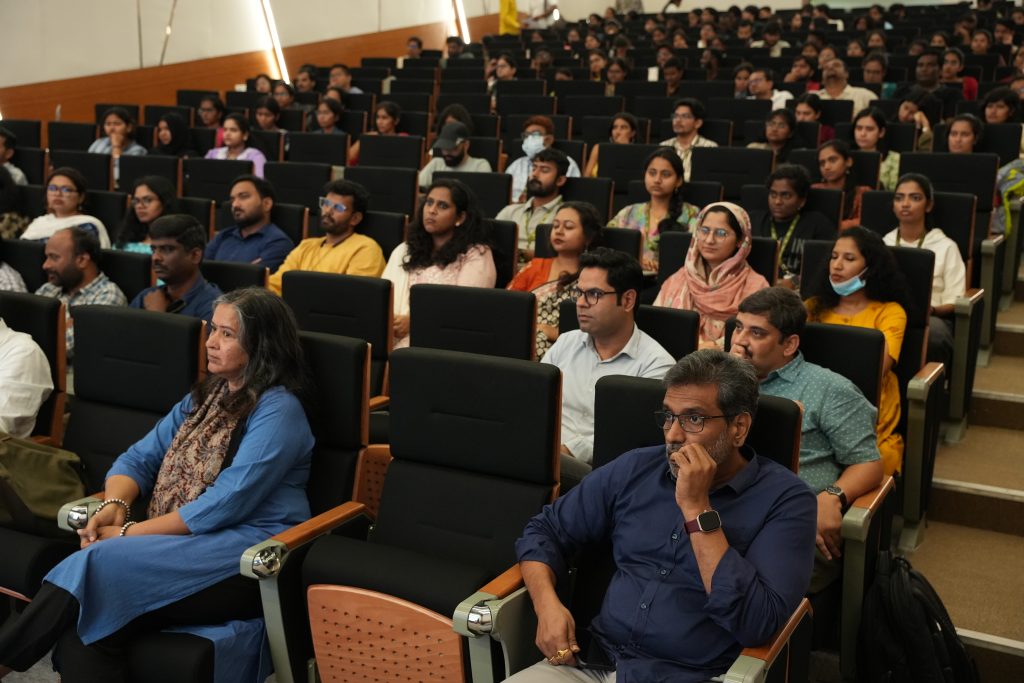Research News
- Padmashri Prof. Shanti Sinha Discuss Child Labour and Child Rights in India at UDL#20 February 24, 2025
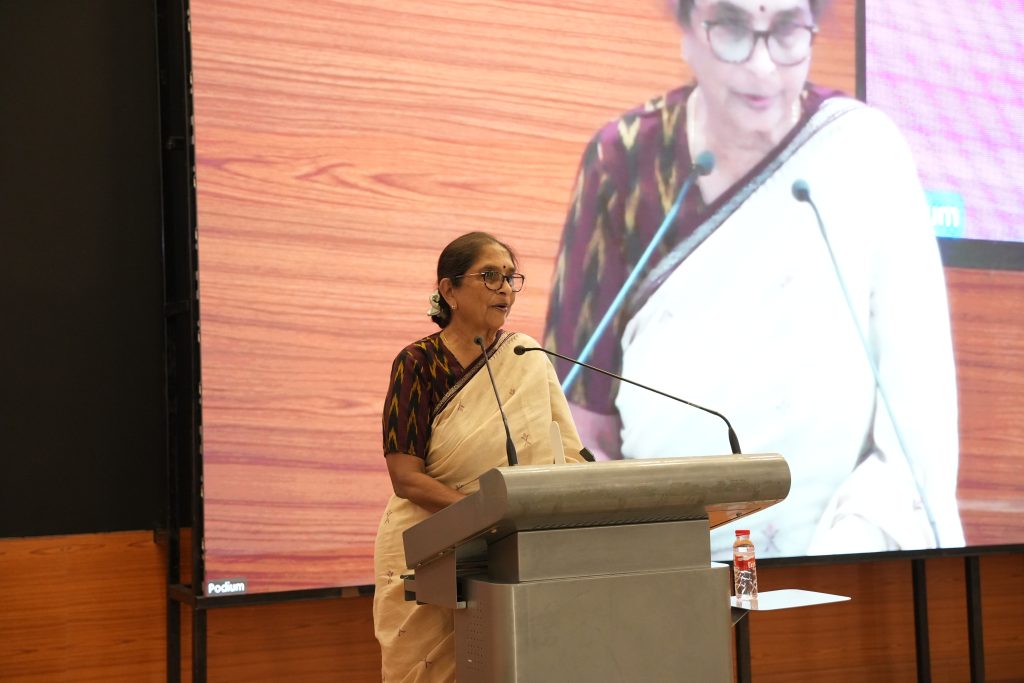
“Every Child Out of School is in Child Labour. Education, Education and Education alone is the Way Forward for a Progressing India.” – Prof. Shanti Sinha
The twentieth edition of the University Distinguished Lecture (UDL) on February 21, 2025, witnessed an invigorating session by the eminent anti-child labour activist Padma Shri Prof. Shanta Sinha, Ramon Magsaysay Awardee, Former Chairperson of the National Commission for Protection of Child Rights (NCPCR), and Professor (Retd.) Dept. of Political Science, Hyderabad Central University. The session on the topic “Making Education a Reality and Ending Child Labour: Experience of M.V. Foundation” gave an overview of the work of M.V. Foundation in the field of child rights in India.
In a society ravaged by poverty, where children were forced to join the bonded labour workforce, Prof. Sinha remarked that it was not poverty that led to child labour but child labour that led to poverty. Prof. Sinha elucidated on the non-negotiable principle adopted by the M.V. Foundation, that ‘no child must work, and every child must attend full-time formal day school,’ which broke the societal norms of Indian society.
She briefly spoke about the impact that the M.V. Foundation had and the ripple it created in the field of child rights. “M.V. Foundation has withdrawn over 15 lakh children in the age group of 5-14 years from child labour; stopped over 20,000 child marriages and pioneered a program for mainstreaming children to schools through residential bridge courses. The MVF’s mission to abolish child labour also led to the Closure of Night Schools and the creation of necessary amendments in the Child Labour Act of 1986,” stated Prof. Sinha.
The session also discussed Prof. Sinha’s Journey at the National Commission for Protection of Child Rights (NCPCR), and the various challenges faced in addressing key issues such as violation of children’s rights in relation to child labour and child trafficking, rights of children in areas of civil unrest, juvenile justice system, corporal punishment, child abuse and violence on children, and child malnutrition.
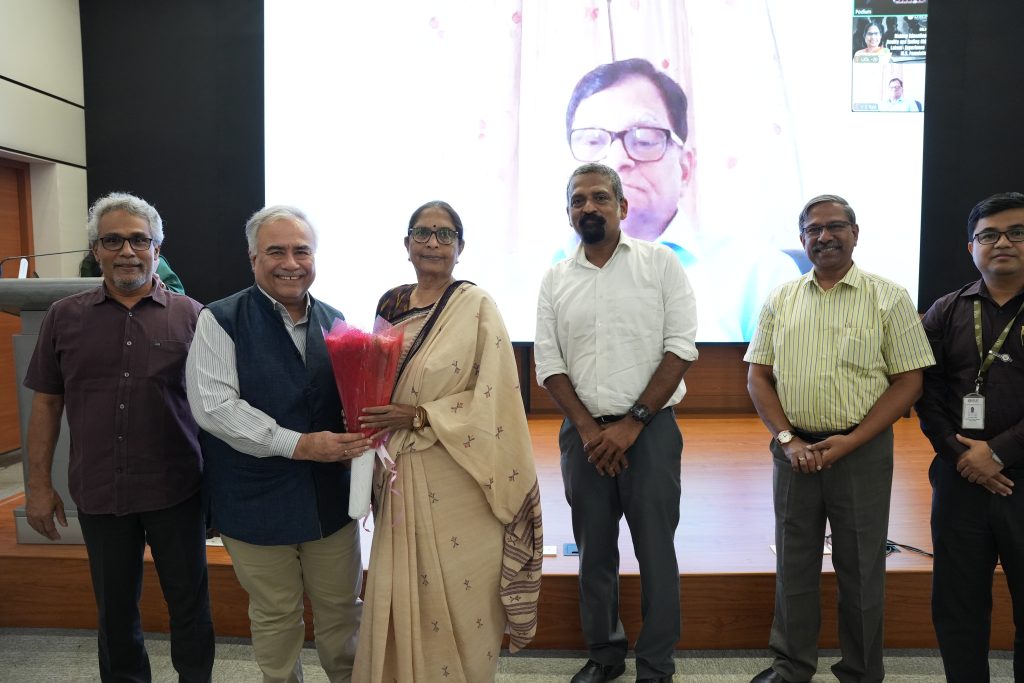
The UDL 20 was a mind opener and a lens into the reality of child labour still prevalent in India. Prof. Manoj K Arora, Vice Chancellor of SRM University-AP, expressed his gratitude to have the presence of a torchbearer of social reform at the UDL. He stated, “Prof. Sinha is a stalwart whose work has created a magnitudinal shift in the societal norm, significantly contributing to the abolition of child labour in India. We are grateful to imbibe from her knowledge and experience as a social leader.” Dean of Easwari School of Liberal Arts, Prof. Vishnupad, also expressed his heartfelt appreciation for Prof. Sinha’s presence and her work. He stated that the thought-provoking and inspiring session will ignite students to think in a ‘non-conventional’ way and offer courage to make a change.
The 20th UDL was organised under the aegis of the Office of Dean-Research, the UDL committee, and the Easwari School of Liberal Arts. It witnessed the presence of Registrar Dr R Premkumar, Dean of the School of Engineering and Sciences, Prof C V Tomy, Dean of Research, Prof. Ranjit Thapa, and Faculty and students of the varsity. The signature lecture series is the university’s flagship initiative to impart global exposure and quality education to its students.
Continue reading → - Patent on CBVR Published by Dr Jatindra Dash February 19, 2025
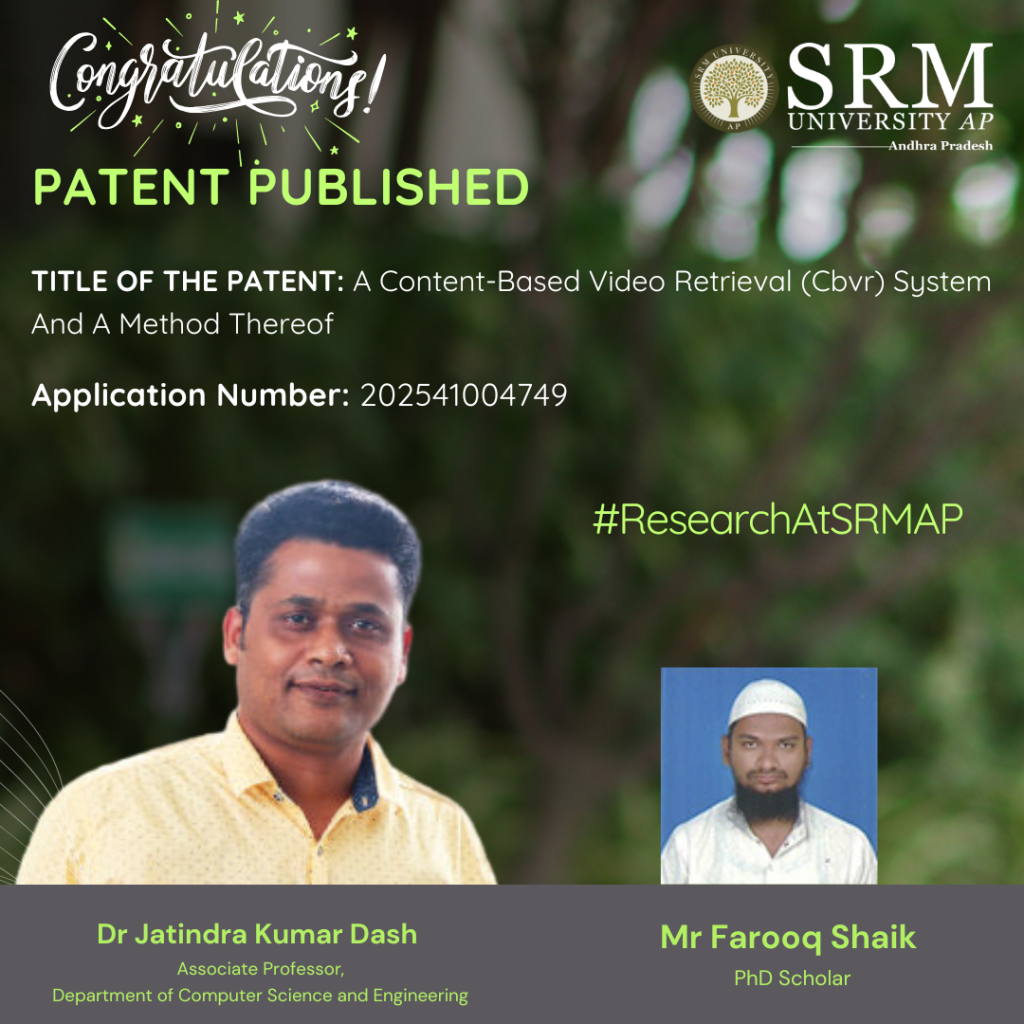 The Department of Computer Science and Engineering is delighted to announce the publication of a patent titled “A Content-Based Video Retrieval (CBVR) System and Method Thereof,” with application number 202541004749. The invention offers an efficient and accurate approach developed for content-based video retrieval by Dr Jatindra Kumar Dash, Associate Professor in the Department, along with his PhD scholar, Mr Farooq Shaik.
The Department of Computer Science and Engineering is delighted to announce the publication of a patent titled “A Content-Based Video Retrieval (CBVR) System and Method Thereof,” with application number 202541004749. The invention offers an efficient and accurate approach developed for content-based video retrieval by Dr Jatindra Kumar Dash, Associate Professor in the Department, along with his PhD scholar, Mr Farooq Shaik.Brief Abstract:
Imagine searching for a specific scene in a movie, not by remembering its title or actors, but by describing the action itself. This is the essence of content-based video retrieval (CBVR), a technique that searches for a video based on what’s inside it, rather than relying solely on manually assigned labels. Unlike traditional methods, which can be time-consuming, error-prone, and struggle with vast datasets, CBVR offers a more efficient and accurate approach. Our proposed system leverages the strong capability of deep learning, a subset of artificial intelligence, to analyse videos and extract their key characteristics. This process occurs in two stages: offline and online. Through the first stage, important features are extracted from all videos in the dataset and stored for future use. When a user submits a query video, its features are extracted in real-time (online) and compared to the stored features of all videos. The videos with features most similar to the query, essentially those with the “closest match” are then presented to the user. To capture the full essence of a video, our system employs a two-stream neural network architecture. This innovative approach allows us to extract both temporal features, which capture the changes and motion patterns within the video (think: someone running or jumping), and spatial features, which pivot about the static visual content of each individual frame (think: the objects and scene depicted).By utilizing a pre-trained neural network called ResNet-60, our system benefits from existing knowledge and can efficiently extract meaningful features from videos. To evaluate its effectiveness, we tested our system on the UCF101 dataset, a widely used benchmark consisting of 101 categorized videos. Our approach obtained accuracy 93,7\% for top 5 retrieval and 95.95\% for top 10 retrieval. The outcomes illustrate that our approach obtains superior accuracy compared to other state-of-the-art video retrieval methods.
Explanation in Layperson’s Terms:
Most of video searching platforms relay on meta data attached to video to search and retrieve videos. For example you tube utilize video name description attached to video while uploading. How ever this approach is time consuming, error prone, and need human intervention. Our proposed CBVR system aims to retrieve videos based on content of video similarity rather than meta tags. Proposed article utilized pre trained Deep neural network particularly ResNet-50 a convolutional neural network with residual skip connections to learn video representation by employing LBP representation and Temporal map of the video.
Practical Implementation and Social Implications
The research focus on CBVR a technique that enables users to search videos based on content rather than meta tags. It has many practical implementations in various industries, such as Surveillance and security (like to search large surveillance feed particular incident), Health care and medical imagining(where doctor retrieve similar medical video for faster diagnosis), Education , Entertainment.
The research has significant social implications such as Improved accessibility to information, enhanced public safety, Advancing ai in daily lifes. Using this system in smart cities and digital systems.
Collaborations
Experiments are conducted on publicly available Dataset on DGX-1 server available at our university premises. In future we may plan to collaborate with local authorities for real time video feed to enhance proposed method capabilities.
Future Research Plans
Further in to research our plan is to propose a robust system that can be scaled and applied to all scenarios of videos may it be Medical videos, Education. Further proposed method is supervised approach, we want to explore unsupervised methods to generalize video retrieval.
Continue reading →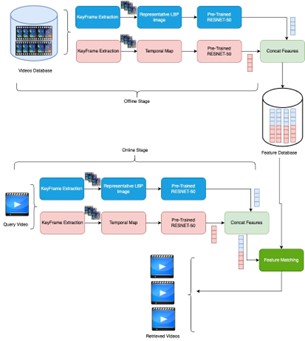
- Dr Debajyoti’s Research on Improving Biofuel Production February 19, 2025
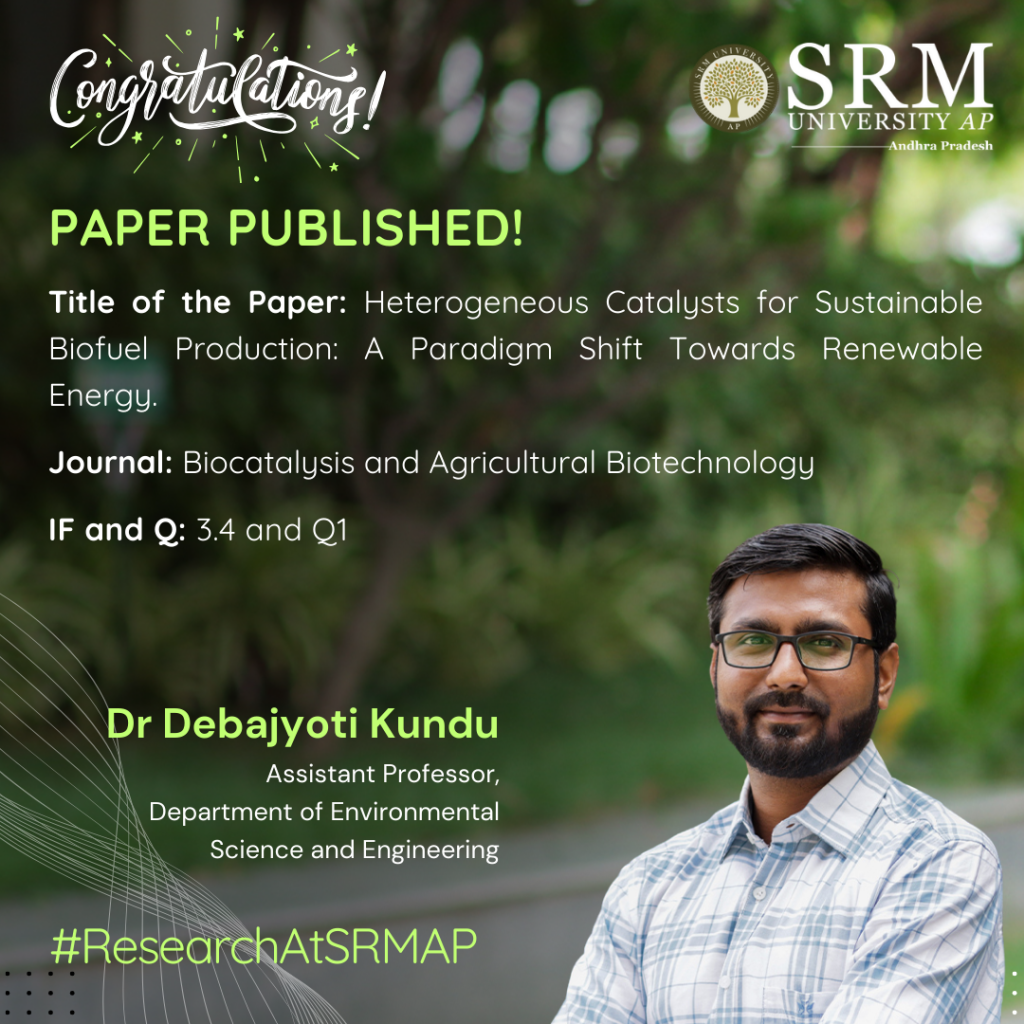 In the quest for sustainable energy solutions, Dr Debajyoti Kundu, from the Department of Environmental Science and Engineering, examines the potential of biofuels through his research paper – “Heterogeneous Catalysts for Sustainable Biofuel Production: A Paradigm Shift Towards Renewable Energy.” The paper highlights the importance of heterogeneous catalysts for improving biofuel production efficiency. The research also suggests future research to support sustainable energy practices.
In the quest for sustainable energy solutions, Dr Debajyoti Kundu, from the Department of Environmental Science and Engineering, examines the potential of biofuels through his research paper – “Heterogeneous Catalysts for Sustainable Biofuel Production: A Paradigm Shift Towards Renewable Energy.” The paper highlights the importance of heterogeneous catalysts for improving biofuel production efficiency. The research also suggests future research to support sustainable energy practices.Brief Abstract:
This study focuses on the use of heterogeneous catalysts for sustainable biofuel production. With the growing concerns around fossil fuel depletion and environmental pollution, biofuels derived from biomass are emerging as promising alternatives. The article explores the significant role of heterogeneous catalysts in enhancing biofuel production by improving conversion efficiency, recyclability, and environmental impact. By analyzing various biomass sources, structural compositions, and the application of catalysts in bioethanol, biobutanol, biodiesel, biogas, and biohydrogen production, the study highlights recent advancements and provides recommendations for future research to drive sustainable energy solutions.
Explanation in layperson’s terms:
This research looks at how we can produce more environmentally friendly fuels from natural materials like plants and waste. Traditional fuels like oil and coal are harmful to the environment, so we are turning to biofuels made from biomass (such as plants) as a cleaner alternative. A key part of making biofuels efficiently is using special catalysts—materials that help speed up chemical reactions. The study examines how different catalysts are used to convert biomass into biofuels such as bioethanol, biodiesel, and biogas. The goal is to improve the processes, making biofuels more sustainable and accessible for the future.
Practical Implementation and Social Implications:
This research has significant implications for advancing renewable energy. The use of heterogeneous catalysts can make biofuel production more efficient and environmentally friendly, reducing reliance on fossil fuels and mitigating climate change. By optimizing biofuel production processes, we can develop cleaner energy solutions that are sustainable, carbon-neutral, and beneficial for the environment. This study also supports the ongoing shift towards renewable energy, ensuring that biofuels can contribute to reducing global energy crises and health risks associated with fossil fuel use.
Future Research Plans
Our future research will focus on the development and optimization of biocatalysts for the bioconversion of biomass into biofuels. We aim to enhance the efficiency and sustainability of biocatalytic processes, exploring new catalysts and reaction conditions that can improve the conversion of various biomass feedstocks into valuable biofuels. This research will contribute to advancing biofuel production technologies, with an emphasis on reducing environmental impact and improving the scalability of bioconversion processes for renewable energy solutions
Continue reading → - Developing Organic Thin-Film Transistors into Biosensors February 17, 2025

The Department of Electronics and Communication Engineering is proud to announce that Dr Durga Prakash M and his scholar Prasanthi Ms Prasanthi Lingala have their invention titled “An Organic Thin-Film Transistors (OTFTs) with Steep Subthreshold and Ultra-Low Temperature Solution Processing for Label-Free Biosensing” published in the Indian Patent Office Journal with the Application Number: 202541000088. Their research focus on developing an Organic Thin-Film Transistor (OTFT) that is able to work as a biosensor in detecting diseases or for real-time health monitoring.
Abstract
Organic Thin-Film Transistor (OTFT): The name “organic thin-film transistor” (OTFT) refers to a type of transistor that employs organic semiconductor materials in its active layer rather than the more traditional inorganic materials such as silicon. Optical thin-film transistors (OTFTs) are distinguished by their adaptability, low fabrication cost, and optimal applicability for electronic devices that are lightweight and portable. Considering their high sensitivity to changes in the surrounding environment and their compatibility with functionalised layers for the detection of biomolecules, these transistors find widespread application in the field of biosensors.
Explanation of the Research in Layperson’s Terms
Imagine a flexible electronic switch that can be bent, stretched, and used in lightweight devices—this is what an Organic Thin-Film Transistor (OTFT) does! Unlike traditional transistors made from rigid silicon, OTFTs use special organic materials, making them more adaptable for wearable sensors, flexible displays, and medical devices.
The research focuses on how these transistors can be used as biosensors, meaning they can detect tiny changes in the environment, like the presence of certain chemicals or biomolecules. This is important for medical testing, where OTFTs could help develop low-cost, highly sensitive diagnostic tools—imagine a simple patch that can detect diseases from sweat or a flexible sensor for real-time health monitoring! By improving how OTFTs interact with biological substances, the team aims to make them more accurate, efficient, and reliable for next-generation healthcare and wearable technology.
Continue reading →
Fig.: Schematic structure of DNTT based OTFT
- Patent on Controlling DC-DC Buck Power Converters January 30, 2025
 The patent titled “A System to Control Dc-Dc Buck Power Converter And A Method Thereof” by research scholar K Mounika Nagabushanam, and Assistant Professors, Dr Somesh Vinayak Tewari, and Dr Tarkeshwar Mahto with application no: 202441098288 presents an innovative approach to managing power conversion in renewable energy systems extending its applications in electric vehicles and microgrids, highlighting the importance of robust power control in advancing sustainable energy technologies.
The patent titled “A System to Control Dc-Dc Buck Power Converter And A Method Thereof” by research scholar K Mounika Nagabushanam, and Assistant Professors, Dr Somesh Vinayak Tewari, and Dr Tarkeshwar Mahto with application no: 202441098288 presents an innovative approach to managing power conversion in renewable energy systems extending its applications in electric vehicles and microgrids, highlighting the importance of robust power control in advancing sustainable energy technologies.Abstract
The work disclosed a system to control DC-DC buck power converter and a method thereof. The system comprises a photovoltaic (PV) panel, a first DC-DC buck converter for voltage step-down, and a battery for energy storage. A bidirectional DC-DC converter manages power flow between the battery and the source bus, while a second bidirectional converter exchanges power with the AC grid. The load bus integrates a second DC-DC buck converter to regulate power for constant power loads and resistive loads. Switching components like IGBTs controlled through PWM signals, ensure precise power control. Inductive and capacitive elements stabilize voltage, filter ripples, and reduce noise. The system supports adaptive power distribution and robust load handling, ensuring efficient energy management.
Explanation in layperson’s terms
Passivity-based control (PBC) is a control technique applied to buck converters within renewable energy systems to maintain stability and efficiency despite varying input conditions. Buck converters are essential for stepping down fluctuating voltage outputs from renewable sources, such as solar panels, to a consistent level suitable for storage or direct use. In solar power systems, PBC is used to manage the voltage conversion from solar panels to batteries or the grid. It stabilizes the voltage output, ensuring efficient battery charging and smooth integration with the electrical grid. PBC’s application in renewable energy systems demonstrates its critical role in advancing sustainable energy technologies, providing a reliable and efficient power supply.
Practical and Social Implications
The proposed control can be used in Electric Vehicle, Microgrid applications to stabilize voltage under load variations.
Future research plans
Future research plan is to work on the testing of proposed control with high level DC-DC converters
Continue reading →

- Book Chapter on Wastewater Treatment and Energy Production January 29, 2025
 In an era where sustainable energy and environmental conservation are paramount, integration of Microalgae with Microbial Fuel Cells for Wastewater Treatment and Energy Generation emerges as a groundbreaking contribution to biotechnology. The book chapter, “Application of Microalgae-MFC to Mitigate Water Pollution and Resource Recovery” authored by Post-doctoral Research Scholar, Dr Ricky Rajamanickam under the guidance of Associate Professor and Head of the Department of Environmental Science and Engineering, Dr Rangabhashiyam Selvasembian explores the revolutionary potential of microalgae-driven microbial fuel cells (MFCs) in tackling wastewater pollution while generating renewable energy. This work—featured in the book titled, Emerging Trends in Microbial Electrochemical Technologies for Sustainable Mitigation of Water Resources Contamination brings together leading experts offering invaluable insights for scientists, engineers, and policymakers striving for a cleaner and greener future.
In an era where sustainable energy and environmental conservation are paramount, integration of Microalgae with Microbial Fuel Cells for Wastewater Treatment and Energy Generation emerges as a groundbreaking contribution to biotechnology. The book chapter, “Application of Microalgae-MFC to Mitigate Water Pollution and Resource Recovery” authored by Post-doctoral Research Scholar, Dr Ricky Rajamanickam under the guidance of Associate Professor and Head of the Department of Environmental Science and Engineering, Dr Rangabhashiyam Selvasembian explores the revolutionary potential of microalgae-driven microbial fuel cells (MFCs) in tackling wastewater pollution while generating renewable energy. This work—featured in the book titled, Emerging Trends in Microbial Electrochemical Technologies for Sustainable Mitigation of Water Resources Contamination brings together leading experts offering invaluable insights for scientists, engineers, and policymakers striving for a cleaner and greener future.Brief Introduction to the Book Chapter
The chapter explores the integration of microalgae with microbial fuel cells (MFCs) for simultaneous wastewater treatment and energy generation. It delves into the mechanisms of microalgae-based MFCs, focusing on electricity generation, carbon capture, and the production of value-added bioproducts. The work highlights this technology’s potential for addressing water pollution and resource depletion while advancing sustainable energy solutions.
Significance of the Book Chapter
This chapter is significant as it addresses pressing global challenges such as water pollution, resource depletion, and the need for sustainable energy solutions. It aligns with the Sustainable Development Goals and contributes to advancing integrated biotechnological solutions for environmental and energy challenges.
Target Audience
The book chapter targets environmental scientists, engineers, policy makers, and researchers working in biotechnology, wastewater management, and renewable energy. It is also resourceful for students and professionals interested in sustainable development and innovative biotechnologies.
Co-Authors or Major Contributors
Dr Ricky – (First author) (Postdoc)
Dr Rangabhashiyam Selvasembian (Corresponding author) (Associate Professor)

Continue reading → - Synthesising Flexible Solid-state Electrolytes for Electronic Devices January 29, 2025

Dr Chinmoy Das, Assistant Professor from the Department of Chemistry, and scholars Mr Sushant Wakekar and Mr Sasikumar K have published their invention titled “Li-based solid-state electrolyte and a method for its preparation” in the Indian Patent Office (Patent application No. 202441083351). The invention illustrates how to synthesise inexpensive Li(I) ion-based solid-state electrolytes that are feasible for fabricating flexible electronic devices. The team worked on inexpensive and readily available starting materials that provide self-supported and flexible solid-state electrolytes to advance LIB applications.
Abstract
In our invention, we described a rapid and robust synthetic methodology to prepare novel flexible solid-state electrolytes (SSEs) suitable for the fabrication of eco-friendly lithium-ion batteries (LIBs). The mechanically flexible film has been synthesized upon in situ incorporation of Li(I) ion into two inexpensive biocompatible polysaccharide matrices through mixing. We achieved Li(I) ion-based superionic conductivity at room temperature which is feasible for the fabrication of flexible electronics in modern age society.

Practical Implementation/Social Implications of the Research
This invention can be implemented in various industries, such as electric vehicles (EVs), wearable and flexible electronics, and aerospace and aviation.
The team is extending their research towards the fabrication of cheaper sodium (Na+), potassium (K+)-ion based solid-state electrolytes with superionic conductivity and implementing them in designing the biodegradable sodium-ion / potassium ion batteries (NIBs / KIBs).
Continue reading → - A Novel System for Breast Cancer Diagnosis January 29, 2025

Faculty duo from the Department of Electronics and Communication Engineering, Dr Anirban Ghosh and Dr Sunil Chinnadurai, along with their research cohort, Phanindra Rayapudi Venkata, Baswala Srujana, Gadde Saranya, and Abburi Sowgandhi (B.Tech. ECE students) have published their patent titled “A System and Method for Breast Cancer Diagnosis” (Application number: 202441088356). Their cutting-edge research presents a system to help diagnose breast cancer more accurately and efficiently using advanced image analysis techniques.
Abstract
The present disclosure discloses a system for diagnosing breast cancer that utilizes topological data analysis to transform mammogram images into meaningful diagnostic insights. It includes a data preprocessing module for image standardization and enhancement and a feature extraction module to create histograms for topological analysis. The topological data analysis module converts these histograms into Persistent Homology Diagrams (PHDs) representing topological features. An Earth Mover’s Distance (EMD) matrix is generated by a similarity metric module to compare PHDs. Representative PHDs are identified using a representative selection module, enabling accurate classification by the classification module. The system’s performance is assessed through various metrics by a performance analysis module, and a web service module provides an intuitive interface for users to upload images and receive diagnostic results. This approach enhances breast cancer detection by focusing on persistent topological features, offering improved precision and interpretability.

Figure 1. Conversion of mammograms into PHDs
Explanation of the Research in Layperson’s Terms
Here’s how the system works in simple terms:
1. Preparing the Images: Mammogram images are cleaned and adjusted to ensure they’re clear and easy to analyse. The focus is on areas that might show signs of cancer.
2. Extracting Patterns: The system looks for patterns in the images that could indicate healthy or unhealthy tissue. It turns these patterns into a visual map that represents the shape and structure of the tissue.
3. Analysing Shapes: The system uses math to study how these shapes appear and disappear as the image details change. The most persistent shapes (important ones) are kept, and random noise is ignored.
4. Comparing Images: A tool measures how similar or different these patterns are between images. This helps the system group them into healthy or cancerous categories.
5. Making a Decision: The system compares a new mammogram to its library of known patterns to decide whether it’s likely healthy or shows signs of cancer.
6. Easy to Use: Doctors can upload an image to a web-based tool and quickly get results, complete with visual explanations.
This system helps doctors by making the diagnosis process faster, more reliable, and easier to understand, which can lead to earlier and better treatment for breast cancer.
Practical Implementation/Social Implications of the Research
This research enhances breast cancer detection by enabling earlier, more accurate diagnoses and improving survival rates. Its web-based tool ensures access to advanced diagnostics in remote and underserved areas, reducing disparities in healthcare. Supporting radiologists with objective insights minimizes errors and workload, especially in resource-limited settings. Patients benefit from faster, clearer results, leading to timely and cost-effective treatment. Additionally, the innovative methods could inspire advancements in diagnosing other diseases, driving broader medical progress and improving global health outcomes.
Future Research Plans
Future research could expand this system to detect other diseases like lung or liver cancer, improve diagnostic accuracy by reducing false results, and integrate multimodal data for comprehensive analysis. Incorporating patient-specific information for personalized risk assessments, creating self-learning models, and optimizing computational efficiency could enhance its adaptability. Large-scale global trials and user-friendly interfaces would ensure effective implementation across diverse populations and healthcare systems, making the technology more versatile, accessible, and impactful.
Continue reading → - The Anxiety of Indianness in the Making of Sindhi Literature January 28, 2025

Very often, it is assumed that the “vernacular” language texts in India do not undergo any anxiety of proving themselves Indian while works written in English do. In her research paper, “A Literature of Frustration and Failure”: The Anxiety of Indianness in the Making of Sindhi Literature as an Indian Literature”, published in the esteemed Q2 journal Journal of Sindhi Studies, Dr Soni Wadhwa, Assistant Professor, Department of Literature and Languages, focuses on Sindhi post literary activity that unfolded in the first 20 years after independence to show that Sindhi has a history of going through anxiety of belonging in India.
Abstract
Studies of Partition frequently turn to literature to understand how displacement processes, among other things, impact aesthetics and representation. The article takes a broader view of aesthetics as representation: it demonstrates how turning to the literary archive of a moment and a community gives rise to questions about the politics of individual texts and literary historiography. Centred on Sindhi literature produced in India after Partition, it shows that examining the literary productivity of the community needs to involve questions of literature as political survival. It focuses on the earliest essays from the Sindhi literary scene in India (published in the Sahitya Akademi journal Indian Literature). The article argues that these essays register anxiety about the survival of a language trying to come into being in an already existing and complicated language-nation relationship. It unpacks three registers of anxiety visible in the literary archive to broaden the scope of the conversations around the Sindhi language and its literature.
This research has been conducted to advance interest in and conversations around Sindhi literature in India. Since Sindhi does not have a state in India, most people are not aware that it exists as a language and that it has a rich literary tradition.
After this article, Dr Soni Wadhwa intends to explore different writers, themes, and movements in Sindhi literature.
Collaborations
The research has been funded by George Mason University.
Continue reading → - Interdisciplinary Research on Groundwater Fluoride Contamination January 28, 2025
 Assistant Professors – Dr Kousik Das, Dr Harish Puppala, Associate Professor- Dr Pankaj Pathak, Uttiya Dey, along with Research Scholars – Mr Mijanur Mondal, Ms Sudeshna Chell, Ms Sumana Dutta, and Ms Pankaj Kumar come up with an interdisciplinary research breakthrough in their paper, “Community-Level Vulnerability of Groundwater Fluoride Contamination and Exposure by the Application of Multi-Criteria Model.” The authors examine fluoride exposure in villages like Chintal Cheruvu, Rompicherla, Shantamangalur, Thimmapur, and Nadendla.
Assistant Professors – Dr Kousik Das, Dr Harish Puppala, Associate Professor- Dr Pankaj Pathak, Uttiya Dey, along with Research Scholars – Mr Mijanur Mondal, Ms Sudeshna Chell, Ms Sumana Dutta, and Ms Pankaj Kumar come up with an interdisciplinary research breakthrough in their paper, “Community-Level Vulnerability of Groundwater Fluoride Contamination and Exposure by the Application of Multi-Criteria Model.” The authors examine fluoride exposure in villages like Chintal Cheruvu, Rompicherla, Shantamangalur, Thimmapur, and Nadendla.Abstract
Elevated fluoride (F⁻) levels in groundwater, primarily due to geogenic processes, pose significant health risks, including dental and skeletal fluorosis and neurological disorders. This study aimed to quantify source-dependent F⁻ exposure at the community level in selected tropical dry regions of Andhra Pradesh, India. These locations include Chintal Cheruvu, Rompicharala, Shantamangalur, Thimmapur, and Nadendla. Community surveys and drinking water sample analyses were conducted in these regions. Dental Fluorosis Index (DFI) used to estimate exposure levels across age and sex groups. Findings of surveys indicate that groundwater consumption with high F⁻ (4.3 mg/L) results in the highest exposure dose (0.62 mg/kg/day), with Chintal Cheruvu identified as the most affected. A strong positive correlation was observed between exposure dose, water F⁻ content, and the Community Fluorosis Index (CFI). Dental fluorosis prevalence exceeded 80% across all age groups, and household surveys revealed 100% unawareness of F⁻ exposure risks. The magnitude of FII for Chintal Cheruvu is 0.563 which is highest among the considered regions indicating that it is most impacted region that needs remedial measures first in the hierarchy. Rompicharala with FII as 0.252, Nadendla (0.223), Shantamangalur (0.214), and Thimmapur (0.188) follows the hierarchy.
Explanation in layperson’s terms.
The outcome of the study concludes that regionally most of the places of Andhra Pradesh is affected the by the groundwater fluoride contamination. People are getting affected by the consumption of high fluoridated water which is visible from the dental fluorosis. The area is having high groundwater fluoride is having highest severe dental fluorosis cases. Among the villages, Chintal Cheruvu had the highest fluoride level while Thimmapur had the lowest. Signs of dental fluorosis were most noticeable among younger individuals who are still developing. The exposure dose varied across villages, with Chintal Cheruvu having the highest exposure dose followed by Rompicharala. Other symptoms of fluorosis, such as skin allergies and body pain are also predominant. Most villages had alternative sources of drinking water, except for Chintal Cheruvu, where residents continued to use contaminated water due to a lack of alternatives. There is a clear link between lack of awareness about fluoride toxicity and higher exposure levels as apparent from the questionnaire survey.
Practical /Social Implications
The immediate action is necessary to reduce fluoride exposure, provide safe drinking water, and raise awareness about fluoride toxicity to meet sustainable development goals by 2030. The findings highlight the need for integrated approaches combining mitigation, education, and sustainable practices to tackle fluoride contamination and improve the overall well-being of affected communities.
Continue reading →


